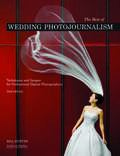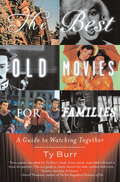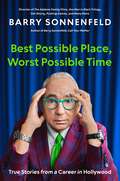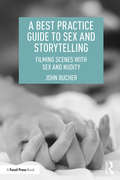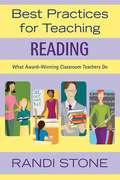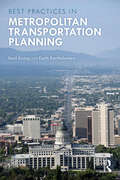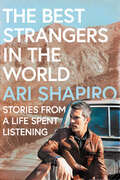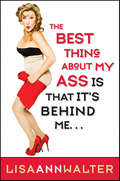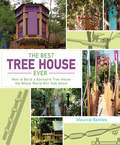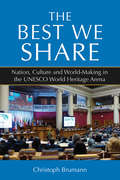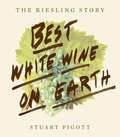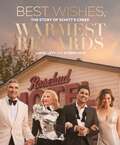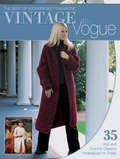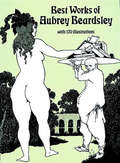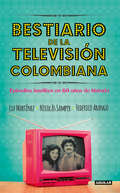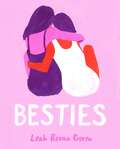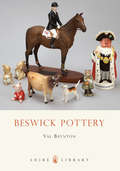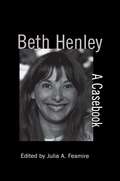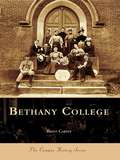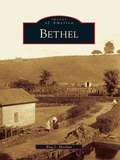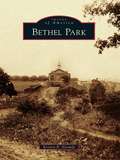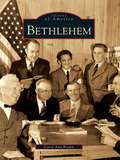- Table View
- List View
The Best of Wedding Photojournalism: Techniques and Images for Professional Digital Photographers
by Bill HurterIn contrast to a traditional wedding photographer, a wedding photojournalist works unobtrusively to capture the #147;real life” flavor of the special event as it unfolds, and this guidebook addresses the unique challenges and specific preparations required to excel in this field. Calling upon the best and brightest photojournalists to share their images and insights, this updated edition reveals the secrets for capturing all the breathtaking exchanges between the personalities, so that the photographs tell a story rich in detail. Many topics are also covered, such as how to meet and mingle with the main players at a wedding, what to expect in terms of a timeline, what shots cannot be missed, and how to minimize the distractions of flashes, bulky equipment, and verbal requests. Before, during, and after the ceremony#151;indoors and out#151;this volume is brimming with advice for every aspect of the shoot, including selecting equipment and lighting, working with an assistant, properly archiving digital files, and selecting a beautiful heirloom-quality album design.
The Best of Wedding Photojournalism
by Bill HurterIn contrast to a traditional wedding photographer, a wedding photojournalist works unobtrusively to capture the "real life" flavor of the special event as it unfolds, and this guidebook addresses the unique challenges and specific preparations required to excel in this field. Calling upon the best and brightest photojournalists to share their images and insights, this updated edition reveals the secrets for capturing all the breathtaking exchanges between the personalities, so that the photographs tell a story rich in detail. Many topics are also covered, such as how to meet and mingle with the main players at a wedding, what to expect in terms of a timeline, what shots cannot be missed, and how to minimize the distractions of flashes, bulky equipment, and verbal requests. Before, during, and after the ceremony--indoors and out--this volume is brimming with advice for every aspect of the shoot, including selecting equipment and lighting, working with an assistant, properly archiving digital files, and selecting a beautiful heirloom-quality album design.
The Best Old Movies for Families
by Ty BurrIf a child can watch Barney, can't that same child also enjoy watching Charlie Chaplin or the Marx Brothers? And as they get older, wouldn't they grow to like screwball comedies (His Girl Friday), women's weepies (Imitation of Life), and westerns (The Searchers)? The answer is that they'll follow because they'll have learned that "old" does not necessarily mean "next channel, please."Here is an impassioned and eminently readable guide that introduces the delights of the golden age of movies. Ty Burr has come up with a winning prescription for children brought up on Hollywood junk food. FOR THE LITTLE ONES (Ages 3--6): Fast-paced movies that are simple without being unsophisticated, plainspoken without being dumbed down. Singin' in the Rain and Bringing Up Baby are perfect.FOR THE ONES IN BETWEEN (Ages 7--12): "Killer stories," placing easily grasped characters in situations that start simply and then throw curveballs. The African Queen and Some Like It Hot do the job well.FOR THE OLDER ONES (Ages 13+): Burr recommends relating old movies to teens' contemporary favorites: without Hitchcock, there could be no The Texas Chainsaw Massacre, without Brando, no Johnny Depp.From the Trade Paperback edition.
Best Possible Place, Worst Possible Time: True Stories from a Career in Hollywood
by Barry SonnenfeldOne-of-a-kind filmmaker Barry Sonnenfeld tells stories only he can tell, from his blockbuster career with iconic actors, studio execs, and producers. His humor and insight provide an inside glimpse into how Hollywood really works, or how it doesn&’t.Best Possible Place, Worst Possible Time delivers a cavalcade of sometimes baffling, often enlightening, and always funny stories about Sonnenfeld&’s many films and television shows. From battling with studio executives and producers to bad-script-solving on set to coaxing actors into finding the right light and talking faster, Sonnenfeld provides an entertaining master class in how to make commercial art in the face of constant human foible. Over four decades in Hollywood, the mega-franchises include The Addams Family and Men in Black; the critical favorites, Get Shorty and Pushing Daisies; the icons, Will Smith, John Travolta, and Michael Jackson; and the projects that got away, Forrest Gump, Ali, and anything starring Jim Carrey. The true stories escalate from surreal to outrageous to unbelievable. And then there&’s magic hour. But you&’ll never see Hollywood the same way again.
A Best Practice Guide to Sex and Storytelling: Filming Scenes with Sex and Nudity
by John BucherA great deal of storytelling in film and television involves narratives that include sexual situations and nudity. The increased amount of on-line and streaming content outlets has in turn increased the number of narratives that involve these once-taboo subjects. Often, even though directors and producers desire to handle such issues with professionalism, sets become awkward when producing these scenes. A Best Practice Guide to Sex and Storytelling serves as a helpful tool for guiding creators through these waters. Even as the practice has become more common, the environments in which individuals on both sides of the camera work to create sensitive content have not become any more comfortable. To date, there have been no industry guides and little practical instruction on how to approach such important yet delicate scenes. Sex and Storytelling offers theoretical and practical approaches to creating the most effective content, while honoring the dignity and humanity of everyone involved on-set when sexuality and nudity is a part of the story being told. Drawing on John Bucher’s professional experience in both high- and low-budget environments and including interviews with players from both sides of the camera, this book provides an essential guide to handling sex and nudity for film and television in a professional manner.
Best Practices for Teaching Reading: What Award-Winning Classroom Teachers Do
by Randi StoneFollowing the successful format of the companion volumes for teaching writing, mathematics, science, and social studies, Best Practices for Teaching Reading presents firsthand accounts of outstanding instructional strategies and lessons for teaching reading to students in both elementary and secondary school. Randi Stone brings readers into the classrooms of more than twenty-five award-winning teachers who share their unique and creative strategies for reaching elementary and secondary learners with diverse learning styles and abilities. From getting fourth-grade students excited to study Shakespeare to creating “wonder journals” to incorporating reading in the math classroom, these teachers have tried it all!With forty classroom-tested strategies, Best Practices for Teaching Reading provides practical guidance for building students’ decoding and vocabulary skills while developing their comprehension and motivation for reading. This collection of best practices presents useful tips in getting students to:· Get excited about reading· Make connections between different texts· Become effective writers as well as readers· Use literacy skills across the curriculumVeteran and new teachers alike will find an abundance of fresh ideas to teach reading while helping students build confidence, increase academic achievement, and develop critical thinking skills.
Best Practices in Metropolitan Transportation Planning: New Advances, Approaches, And Best Practices
by Reid Ewing Keith BartholomewPlanning at a metropolitan scale is important for effective management of urban growth, transportation systems, air quality, and watershed and green-spaces. It is fundamental to efforts to promote social justice and equity. Best Practices in Metropolitan Transportation Planning shows how the most innovative metropolitan planning organizations (MPOs) in the United States are addressing these issues using their mandates to improve transportation networks while pursuing emerging sustainability goals at the same time. As both a policy analysis and a practical how-to guide, this book presents cutting-edge original research on the role accessibility plays - and should play - in transportation planning, tracks how existing plans have sought to balance competing priorities using scenario planning and other strategies, assesses the results of various efforts to reduce automobile dependence in cities, and explains how to make planning documents more powerful and effective. In highlighting the most innovative practices implemented by MPOs, regional planning councils, city and county planning departments and state departments of transportation, this book aims to influence other planning organizations, as well as influence federal and state policy discussions and legislation.
Best Story Wins: Storytelling for Business Success (Economist Books)
by Mark EdwardsAn inspiring, practical, and timely new guide on how to harness the power of storytelling in our communications at work. Whether you're standing up in front of a crowd at a conference or chatting with a colleague in an elevator, storytelling is the most effective way to get your point across. It works in ninety-second Superbowl television spots, it works in ten-second social media formats, and it works in that email you have to fire off in five seconds flat. Why? The short answer is that people don't make decisions based on logic. They make decisions based on emotions. To persuade, influence, and inspire, you need to make an emotional connection. And storytelling is the best way of doing that. Journalist-turned-business coach Mark Edwards has developed his own methodology for telling compelling stories at work. Best Story Wins shows how storytelling will make better communicators of us all.
The Best Strangers in the World: Stories from a Life Spent Listening
by Ari ShapiroINSTANT NEW YORK TIMES BESTSELLER“The Best Strangers in the World is a witty, poignant book that captures Ari Shapiro’s love for the unusual, his pursuit of the unexpected, and his delight at connection against the odds.”—Ronan Farrow, Pulitzer Prize-winning investigative journalist and New York Times-bestselling author of Catch and Kill and War on PeaceFrom the beloved host of NPR's All Things Considered, a stirring memoir-in-essays that is also a lover letter to journalism.In his first book, broadcaster Ari Shapiro takes us around the globe to reveal the stories behind narratives that are sometimes heartwarming, sometimes heartbreaking, but always poignant. He details his time traveling on Air Force One with President Obama, or following the path of Syrian refugees fleeing war, or learning from those fighting for social justice both at home and abroad.As the self-reinforcing bubbles we live in become more impenetrable, Ari Shapiro keeps seeking ways to help people listen to one another; to find connection and commonality with those who may seem different; to remind us that, before religion, or nationality, or politics, we are all human. The Best Strangers in the World is a testament to one journalist’s passion for Considering All Things—and sharing what he finds with the rest of us.
The Best Thing About My Ass Is That It's Behind Me
by Lisa Ann WalterActress and comic Lisa Ann Walter offers a hilarious, star-studded collection of essays encouraging women to laugh at what they can't change, enjoy a guilty pleasure or two, and finally accept the lives and the bodies they're in now. The star of shows like Abbott Elementary and movies like The Parent Trap, Shall We Dance, and Bruce Almighty delivers a warm, wry, honest, and effective exhortation to find happiness where you are, in a serenity prayer for today’s woman that’s perfect for fans of Gretchen Rubin’s The Happiness Project, Valerie Bertinelli’s Losing It and Chelsea Handler’s My Horizontal Life.
The Best Tree House Ever: How to Build a Backyard Tree House the Whole World Will Talk About
by Maurice BarkleyWhen his two young grandsons clamored for a hideout in the trees, what could Maurice Barkley, a sixty-something retiree, do but grab some wooden beams and a level? Now, more than ten years, seven tiny houses, and a spiral staircase later, Barkley’s grandkids can truly say they have the best tree house ever. With a backyard that has become a tourist destination and the delighted cries of children playing pretend sounding in his ears, Barkley shares his pro building tips, floor plans, and how-tos in an easy-to-use guide anyone with a hankering for nature and a set of basic carpenter’s tools can follow.The Best Tree House Ever records the creation and growth of a child-sized village built high above the ground and documents the wonderful, unexpected consequences—the visitors, the excitement, and the hundreds of friendships made—that occurred along the way. Filled with plans and construction details of Barkley’s entire tree house village, The Best Tree House Ever leads adventurers of every age to explore the magical worlds hidden amongst the foliage.
The Best We Share: Nation, Culture and World-Making in the UNESCO World Heritage Arena
by Christoph BrumannThe UNESCO World Heritage Convention is one of the most widely ratified international treaties, and a place on the World Heritage List is a widely coveted mark of distinction. Building on ethnographic fieldwork at Committee sessions, interviews and documentary study, the book links the change in operations of the World Heritage Committee with structural nation-centeredness, vulnerable procedures for evaluation, monitoring and decision-making, and loose heritage conceptions that have been inconsistently applied. As the most ambitious study of the World Heritage arena so far, this volume dissects the inner workings of a prominent global body, demonstrating the power of ethnography in the highly formalised and diplomatic context of a multilateral organisation.
Best White Wine on Earth: The Riesling Story
by Stuart PigottA celebrated wine journalist presents a comprehensive, entertaining primer on one of the most beloved wines of our time: Riesling. Diverse, drinkable, aromatic, and refreshing, Riesling is a chameleon among white wines. From its food-friendly flavor and favorable price point to its ability to be either bone-dry or honey-sweet, there are very good reasons to argue that Riesling is not just a popular wine of the moment, but the finest white of our time. In Best White Wine on Earth, wine journalist and Riesling enthusiast Stuart Pigott extols the virtues of his favorite varietal and explores the history behind this magnificent grape. Traveling to the great Riesling-producing regions of the world—from North America to Europe, Australia, New Zealand, and South America—Pigott provides tasting notes, top-rated recommendations, and fascinating insights into how the wine is made, all while making an impassioned case that it is, truly, the best white on earth. Written simply enough for a novice, but with enough expertise and insight to satisfy the most sophisticated collector, this is a must-have guide for any white wine enthusiast.
Best Wishes, Warmest Regards: The Story of Schitt's Creek
by Daniel Levy Eugene LevyThis beautifully produced, lavishly illustrated book is the ultimate celebration of the series, the town, the characters, and the state of mind that is Schitt's Creek. Capturing the essence and alchemy of all six seasons of what is now considered to be one of the most groundbreaking comedy television series of the last decade, Best Wishes, Warmest Regards is a gift to fans everywhere who have made the show their own.Included are character profiles from the cast of Johnny, Moira, David, and Alexis, and all of the characters that populate the town, major moments from Moira's endorsement of Herb Ertlinger Winery, to Patrick and David's first kiss, to Cabaret and the Rose Family Christmas episode. Also included are special features, such as the complete, illustrated catalogs of David's knits and Moira's wigs, Moira's vocabulary, Alexis's adventures, and behind-the-scenes moments from Dan and Eugene Levy and the cast of Schitt's Creek.
Best Wishes, Warmest Regards: The Story of Schitt's Creek
by Daniel Levy Eugene LevyThe official tie-in book for the beloved, nine-time Emmy® Award-winning series Schitt's Creek. This beautifully produced, keepsake coffee-table book is the ultimate celebration of the series, the town, the characters, and the state of mind that is Schitt's Creek. Capturing the essence and alchemy of all six seasons of what is now considered to be one of the most groundbreaking comedy television series of the last decade, Best Wishes, Warmest Regards is a gift to fans everywhere who have made the show their own. <P><P>Included are character profiles from the cast of Johnny, Moira, David, and Alexis, and all of the characters that populate the town, major moments from Moira's endorsement of Herb Ertlinger Winery, to Patrick and David's first kiss, to Cabaret and the Rose Family Christmas episode. Also included are special features, such as the complete, illustrated catalogs of David's knits and Moira's wigs, Moira's vocabulary, Alexis's adventures, and behind-the-scenes moments from Dan and Eugene Levy and the cast of Schitt's Creek. <P><P><b>A New York Times Best Seller</b>
Best Workbasket
by Krause PublicationsKnitting and crocheting have never been so hot - even celebrities like Julia Roberts and Vanna White can be found with a needle or hook. Today's top knitting and crochet designers present updated patterns from Workbasket magazine in this perfect instruction book for anyone wanting to learn these popular crafts! Features 35 projects as they originally appeared, including sweaters, scarves, hats, mittens, and vests. Each project is updated with slight design alterations and then created with today's new specialty yarns and colors.
Best Works of Aubrey Beardsley
by Aubrey BeardsleyIn the brief span of his life and career, Aubrey Beardsley (1872-98) galvanized public attention in 1890s London with his exotic renderings of subjects, which often projected the sensual and the grotesque. This splendid volume brings together the best of Beardsley's work -- a rich selection ranging from illustrations for Laclos's Les Liaisons Dangereuses and Balzac's La Comédie Humaine to magazine cover designs, book plate silhouettes, title-page ornaments, and delightful mini-portraits of major composers. Also included are two photographs of the artist, consisting of private portrait studies by Frederick H. Evans.Over 180 beautifully reproduced black-and-white plates capture the uniqueness of Beardsley's vision and reveal the seductive power of his art. Among the illustrations are brilliantly conceived vignettes from Le Morte D'arthur, Venus and Tannhäuser, Salome, and Lucian's True History as well as enchanting creations for The Yellow Book (an influential British arts quarterly), and much more.Characterized by bold black masses, elongated shapes, and sensually provocative figures, these works are the product of a remarkable individual style that transformed the art of illustration. Reproduced here in an inexpensive high-quality format, they are certain to thrill not only Beardsley enthusiasts but anyone interested in the early years of modern graphic art.
Bestiario de la televisión Colombiana
by Federico ArangoEl cumpleaños número 60 de la televisión colombiana ha servido pararecordar sus más destacados momentos. Este libro pretende todo locontrario: rendirle homenaje a una serie de personajes que más queprotagonistas, casi siempre fueron antagonistas; proyectos que muchoprometieron y nada cumplieron, así como a pintorescas adaptacioneslocales de formatos foráneos que, no por jamás haber ganado un IndiaCatalina o no haber alcanzado la portada de las famosas revistas defarándula, han sido olvidados por los más devotos televidentes. Enresumen, en tiempos en los que el país asume el reto de darle una nuevamirada más incluyente a su pasado, la televisión no se puede quedaratrás y eso es lo que se propone este libro: valorar el aporte depersonajes como Guri-Guri, Farzán, Rapidol o Milipico, resaltar laimportancia de artefactos orgullo de la tecnología criolla como elCuchuflí o la Bocina de Carlina. Y sacar de la papelera de reciclajemental fastuosas megaproducciones como La Dama del pantano, ParaísoTropical o Higuita: Sangre, sudor y lágrimas
Besties
by Leah Reena GorenA fully illustrated celebration of female friendship that is a gift, a thank-you note, and a love letter all in one. Besties smartly captures all the reasons why best friends are . . . well, the best: they help you make decisions, are there through rough patches, and will always be your +1 for awkward parties. Even more than that, best friends are the people with whom dearest memories are shared, whether trivial or meaningful. In a style that is at turns both sweet and quirky, celebrated indie artist Leah Goren illustrates the many ways in which close friendships withstand the test of time, cross-country moves, failed romantic relationships, and silly arguments. Featuring whimsical artwork and a sincere message, this is the book friends both young and mature will want to give each other to show their appreciation.
Beswick Pottery
by Val BayntonBeswick is typical of the numerous small scale ceramic factories founded towards the end of the Victorian era and manufacturing through the first two thirds of the 20th century. Like many of these companies Beswick produced a mix of tableware and sculptural ceramics adjusting its designs to take account of the trends of each decade. However the company is atypical by the very fact of its survival - in spite of the many upheavals which have transformed the ceramic industry during the latter part of the 20th century. Its story is one of evolution from a traditional Victorian Pottery to a 21st century brand.Founded in 1894 by James Wright Beswick, Beswick passed through three generations of family ownership before becoming part of Royal Doulton in 1969 and is now independently owned. As owners and collectors of its products will testify, Beswick aimed, and still aims today, to produce well made ceramics at affordable prices; wares which could be used daily in the home as well as decorative ornaments for animal lovers of all ages to cherish. In this volume Val Baynton explores the diversity of products revealing that far more than horses - for which Beswick was so justifiably famous - were made. Wares are placed in context with the company history and information on important sculptors and designers is also included.
Beth Henley: A Casebook (Casebooks on Modern Dramatists #33)
by Julia A. FesmireBeth Henley was awarded the Pulitzer Prize in Drama and the New York Drama Critics Circle Award for Best American Play for her first full-length play, Crimes of the Heart, yet there has been no book-length consideration of her body of work until now. This volume includes original essays that contextualize and analyze her works from a variety of perspectives, focusing on her vexed status as a southern writer, her use of the comic grotesque, and her alleged feminist critiques of modern society. Receiving special attention are lesser-known plays which are crucial to understanding Henley's development as a playwright and postmodern thinker.
Bethany College
by Brent CarneyHarbored in the halls of ivy-covered buildings, the rich history of Bethany College has inspired thousands of students to pursue higher education amidst the scenic Allegheny foothills. Those who have studied here have come to find that this picturesque, 1,600-acre campus has provided them with more than just a diploma-it has enriched their lives.Founded on March 2, 1840, by Alexander Campbell, Bethany College is the oldest degree-granting institution in West Virginia. Emphasizing intellectual freedom, diversity, personal growth, leadership, and a close academic community capable of cultivating eager minds, Bethany College is dedicated to providing a well-rounded education and producing free-thinking students. In these pages, readers will discover the Bethany of the past-including the vision of founder Alexander Campbell, the inspiration of the Christian Church that supports Bethany's mission, the beautiful historic architecture, the athletic moments that rallied school pride, and the great legacy of alumni and faculty. Accompanied by informative captions, vintage photographs collected from the Archives and Special Collections of the T.W. Phillips Memorial Library capture the Bethany experience, offering readers a unique opportunity to celebrate this institution's vibrant history.
Bethel (Images of America)
by Rita J. SheehanThe town of Bethel is located in Sullivan County, 90 miles northwest of New York City. Bethel was established on March 27, 1809, and the first hotel in the county opened in the hamlet of White Lake in 1846. Hundreds of hotels were to follow, from the Arlington to the Woodlawn Villa. During the silver and golden ages, White Lake became fashionable, and many people flocked to the clean water of the lake, fresh mountain air, and grand hotels. The tanneries, gristmills, and sawmills were prosperous during the 1800s. In 1969, Bethel was the site of the Woodstock Music and Arts Fair that drew nearly 500,000 people to the town. Through vintage images, Bethel recalls this town's vibrant past.
Bethel Park
by Kristen R. NormileAlthough once part of a much larger area of southwestern Pennsylvania, Bethel Park has carved its niche into the rolling hills of Allegheny County with its rich history, interesting stories, and fascinating people. Incorporated in 1886 as Bethel Township, Bethel Park has seen its landscape prosper and change from agricultural to industrial and finally into the largest populated suburb in Allegheny County's South Hills neighborhoods. Advances in transportation and industry transformed Bethel Park into an inviting community of family homes, distinguished schools, and well-established local businesses. Bethel Park was also one of the key sites in the famed Whiskey Rebellion; the location of the first documented armored car robbery; the burial site of famed pop artist Andy Warhol; and the home of well-known writer, producer, and narrator Rick Sebak.
Bethlehem (Images of America)
by Carol Ann BrownSettled in 1734, Bethlehem is a typical Litchfield hill town and retains much of its rural charm. Around its green are an old post tavern at the Woodward House, two historic churches, and the Bellamy-Ferriday House and Garden. Rev. Joseph Bellamy came to Bethlehem in 1738 and stayed to establish the first theological school in the country, educating Aaron Burr, James Morris, and later John C. Calhoun. In 1938, postmaster Earl Johnson designed a rubber stamp to adorn cards sent from the post office attached to his family's general store. This first cachet became an annual project and established Bethlehem as "the Christmas town." In 1946, two Benedictine nuns came to stay with artist Lauren Ford while establishing the Abbey of Regina Laudis in a factory donated by local businessman Robert Leather. Every September for the last 85 years, the Bethlehem Fair has welcomed more than 60,000 people to apple pies and horse draws at its scenic fairgrounds.
